SONY HCD-XB66, HCDXB660 Service Manual

HCD-XB66/XB660
SERVICE MANUAL
E Model
Australian Model
HCD-XB66
Mexican Model
HCD-XB660
HCD-XB66, HCD-XB660 are the tuner, |
|
|
deck, CD and amplifier section in LBT- |
Photo: XB66 |
|
XB66, LBT-XB660. |
||
|
||
|
|
Dolby noise reduction manufactured under license from Dolby Laboratories Licensing Corporation. “DOLBY” and the double-D symbol aare trademarks of Dolby Laboratories Licensing Corporation.
CD |
Model Name Using Similar Mechanism |
HCD290/G330/XB3 |
|
|
|
||
CD Mechanism Type |
CDM37LH-5BD29AL |
||
Section |
|||
|
|
||
|
Base Unit Name |
BU-5BD29AL |
|
|
|
|
|
Tape deck |
Optical Pick-up Name |
KSS-213D/Q-NP |
|
|
|
||
Model Name Using Similar Mechanism |
HCD-H881 |
||
Section |
|||
|
|
||
|
Tape Transport Mechanism Type |
TCM-220WR2 |
|
|
|
|
SPECIFICATIONS
Amplifier section
The following measured at AC 120/240 V, 50 Hz DIN power output (Rated) 140 + 140 watts
(8 ohms at 1 kHz, DIN) Continuous RMS power output (Reference)
170 + 170 watts
(8 ohms at 1 kHz, 10% THD) Peak music power output (Reference)
3,000 watts
Inputs |
|
PHONO IN (phono jacks): |
sensitivity 3 mV, impedance |
|
47 kilohms |
MIX MIC (phone jack): |
sensitivity 1 mV, impedance |
10 kilohms VIDEO/MD (AUDIO) IN (phono jacks):
sensitivity 250 mV, impedance 47 kilohms
Outputs
PHONES (stereo phone jack): accepts headphones of 8 ohms or more VIDEO/MD (AUDIO) OUT (phono jacks):
voltage 250 mV, impedance 1 kilohms
CD player section
System
Laser
Laser output
Wavelength Frequency response Signal-to-noise ratio Dynamic range
CD DIGITAL OUT
(square optical connector jack, rear panel)
Wave length: |
600 nm |
Output level: |
–18 dBm |
|
– Continued on next page – |
SPEAKER: |
accepts impedance of 8 to 16 ohms. |
COMPACT DISC DECK RECEIVER
MICROFILM
Tape player section |
|
Recording system |
4-track 2-channel stereo |
Frequency response (DOLBY NR OFF)
60 - 13,000 Hz (±3 dB), using a Sony TYPE I cassette 60 - 14,000 Hz (±3 dB),
using a Sony TYPE II cassette
Tuner section
FM stereo, FM/AM superheterodyne tuner
FM tuner section |
|
Tuning range |
87.5 - 108.0 MHz (50 kHz step) |
Antenna |
FM wire antenna |
Antenna terminals |
75 ohm unbalanced |
Intermediate frequency |
10.7 MHz |
AM tuner section |
|
Tuning range |
|
(2 band model) |
531 - 1,602 kHz |
|
(with the tuning interval set at 9 kHz) |
|
530 - 1,710 kHz (with the tuning |
|
interval set at 10 kHz) |
(3 band model ) |
|
MW: |
531 -1,602 kHz (with the tuning |
|
interval set at 9 kHz) |
LW: |
153 - 279 kHz (with the tuning |
|
interval set at 3 kHz) |
Antenna |
AM loop antenna, External antenna |
|
terminals |
Intermediate frequency |
450 kHz |
General |
|
Power requirements |
|
Mexican model: |
120 V AC, 50/60 Hz |
Australian and South African models: |
|
|
220 - 240 V AC, 50/60 Hz |
Other models: |
110 -120 V or 220 -240 V AC, |
|
50/60 Hz Adjustable with voltage |
|
selector |
Power consumption |
320 watts |
Dimensions (w/h/d) |
Approx. 355 × 425 × 435 mm (14 × |
|
163/4 × 171/4 in) incl. projecting parts |
|
and controls |
Mass |
Approx. 14.5 kg (31 lb 16 oz.) |
Supplied accessories |
AM loop antenna (1) |
|
Remote RM-SD70S (1) |
|
Size AA (R6) batteries (2) |
|
FM wire antenna (1) |
|
Speaker cords (2) |
Design and specifications are subject to change without notice.
TABLE OF CONTENTS
1. SERVICING NOTES ............................................... |
3 |
2.GENERAL
|
Location of Controls ....................................................... |
4 |
|
Setting the Time .............................................................. |
6 |
3. |
DISASSEMBLY ......................................................... |
7 |
4. |
TEST MODE .............................................................. |
15 |
5. |
MECHANICAL ADJUSTMENTS ........................ |
17 |
6.ELECTRICAL ADJUSTMENTS
TAPE DECK Section ...................................................... |
17 |
CD Section ...................................................................... |
20 |
7.DIAGRAMS
7-1. |
IC Pin Function Description ........................................... |
22 |
7-2. |
Block Diagram – CD Section – ..................................... |
27 |
7-3. |
Block Diagram – TAPE DECK Section – ..................... |
29 |
7-4. |
Block Diagram – MAIN Section (1/2) – ....................... |
31 |
7-5. |
Block Diagram – MAIN Section (2/2) – ....................... |
33 |
7-6. |
Block Diagram – DISPLAY/KEY CONTROL/ |
|
|
POWER SUPPLY Section – ........................................... |
35 |
7-7. |
Printed Wiring Board – CD Section (1/2) – .................. |
39 |
7-8. |
Schematic Diagram – CD Section (1/2) – ...................... |
41 |
7-9. |
Printed Wiring Boards – CD Section (2/2) – ................ |
43 |
7-10. |
Schematic Diagram – CD Section (2/2) – ...................... |
45 |
7-11. Printed Wiring Boards – TAPE DECK Section – ......... |
47 |
|
7-12. |
Schematic Diagram – TAPE DECK Section – ............... |
49 |
7-13. |
Printed Wiring Board – MAIN Section – ...................... |
51 |
7-14. |
Schematic Diagram – MAIN Section (1/3) – ................. |
53 |
7-15. |
Schematic Diagram – MAIN Section (2/3) – ................. |
55 |
7-16. |
Schematic Diagram – MAIN Section (3/3) – ................. |
57 |
7-17. |
Printed Wiring Board – POWER AMP Section – ......... |
59 |
7-18. |
Schematic Diagram – POWER AMP Section – ............. |
61 |
7-19. |
Printed Wiring Board – PANEL Section (1/3) – ........... |
63 |
7-20. |
Schematic Diagram – PANEL Section (1/3) – ............... |
65 |
7-21. |
Printed Wiring Boards – PANEL Section (2/3) – .......... |
67 |
7-22. |
Schematic Diagram – PANEL Section (2/3) – ............... |
69 |
7-23. |
Printed Wiring Boards – PANEL Section (3/3) – .......... |
71 |
7-24. |
Schematic Diagram – PANEL Section (3/3) – ............... |
73 |
7-25. |
Printed Wiring Board |
|
|
– POWER SUPPLY Section – ........................................ |
75 |
7-26. |
Schematic Diagram |
|
|
– POWER SUPPLY Section – ........................................ |
76 |
8. |
EXPLODED VIEWS ................................................ |
81 |
9. |
ELECTRICAL PARTS LIST ............................... |
90 |
– 2 –
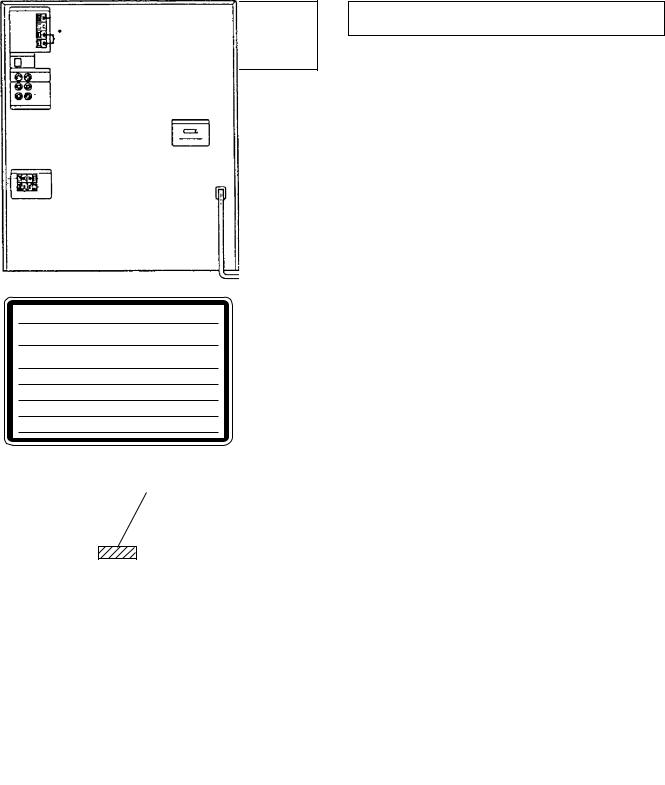
SECTION 1
SERVICING NOTES
CAUTION
Use of controls or adjustments or performance of procedures other than those specified herein may result in hazardous radiation exposure.
This appliance is classified as a CLASS 1 LASER product. The CLASS 1 LASER PRODUCT MARKING is located on the rear exterior.
Laser component in this product is capable of emitting radiation exceeding the limit for Class 1.
The following caution label is located inside the unit.
CAUTION : INVISIBLE LASER RADIATION WHEN OPEN AND
INTERLOCKS DEFEATED. AVOID EXPOSURE TO BEAM.
ADVARSEL : USYNLIG LASERSTRÅLING VED ÅBNING NÅR
SIKKERHEDSAFBRYDERE ER UDE AF FUNKTION. UNDGÅ UDSAETTELSE
FOR STRÅLING.
VORSICHT : UNSICHTBARE LASERSTRAHLUNG, WENN ABDECKUNG GEÖFFNET UND SICHEREITSVERRIEGELUNG ÜBERBRÜCKT. NICHT DEM STRAHL AUSSETZEN.
VARO! : AVATTAESSA JA SUOJALUKITUS OHITETTAESSA OLET ALT-
TIINA NÄKYMÄTTÖMÄLLE LASERSÄTEILYLLE. ÄLÄ KATSO SÄTEESEEN.
VARNING : OSYNLING LASERSTRÅLING NÄR DENNA DEL ÄR ÖPPNAD
OCH SPÄRREN ÄR URKOPPLAD. BETRAKTA EJ STRÅLEN.
ADVERSEL : USYNLIG LASERSTRÅLING NÅR DEKSEL ÅPNES OG
SIKKERHEDSLÅS BRYTES. UNNGÅ EKSPONERING FOR STRÅLEN.
VIGYAZAT! : A BURKOLAT NYITÁSAKOR LÁTH ATATLAN LÉZERSU-
GÁRVESZÉLY ! KERÜLJE A BESUGÁRZÁST !
MODEL IDENTIFICATION
– BACK PANEL –
PART No.
NOTES ON HANDLING THE OPTICAL PICK-UP BLOCK OR BASE UNIT
The laser diode in the optical pick-up block may suffer electrostatic break-down because of the potential difference generated by the charged electrostatic load, etc. on clothing and the human body.
During repair, pay attention to electrostatic break-down and also use the procedure in the printed matter which is included in the repair parts.
The flexible board is easily damaged and should be handled with care.
NOTES ON LASER DIODE EMISSION CHECK
The laser beam on this model is concentrated so as to be focused on the disc reflective surface by the objective lens in the optical pick-up block. Therefore, when checking the laser diode emission, observe from more than 30 cm away from the objective lens.
LASER DIODE AND FOCUS SEARCH OPERATION CHECK
Carry out the “S curve check” in “CD section adjustment” and check that the S curve waveforms is output three times.
Notes on chip component replacement
•Never reuse a disconnected chip component.
•Notice that the minus side of a tantalum capacitor may be damaged by heat.
Flexible Circuit Board Repairing
•Keep the temperature of the soldering iron around 270 ˚C during repairing.
•Do not touch the soldering iron on the same conductor of the circuit board (within 3 times).
•Be careful not to apply force on the conductor when soldering or unsoldering.
|
MODEL |
PART No. |
|
|
|
XB66 |
: E, Argentine models |
4-996-413-0 |
XB66 |
: Mexican model |
4-996-413-2 |
XB66 |
: Australian model |
4-996-413-3 |
XB66 |
: South African model |
4-996-413-4 |
XB660: Mexican model |
4-996-413-8 |
|
|
|
|
SAFETY-RELATED COMPONENT WARNING!!
COMPONENTS IDENTIFIED BY MARK ! OR DOTTED LINE WITH MARK ! ON THE SCHEMATIC DIAGRAMS
AND IN THE PARTS LIST ARE CRITICAL TO SAFE OPERATION. REPLACE THESE COMPONENTS WITH SONY PARTS WHOSE PART NUMBERS APPEAR AS SHOWN IN THIS MANUAL OR IN SUPPLEMENTS PUBLISHED BY SONY.
– 3 –

SECTION 2 GENERAL
LOCATION OF CONTROLS
– Front Panel –
1 |
|
2 3 |
4 |
5 6 |
7 |
|
|
|
|
|
||||||||||||||||
!§ |
|
|
|
|
|
|
|
|
|
|
|
|
|
|
|
|
|
|
|
|
|
|
|
|
8 |
|
|
|
|
|
|
|
|
|
|
|
|
|
|
|
|
|
|
|
|
|
|
|
|
|
|||
|
|
|
|
|
|
|
|
|
|
|
|
|
|
|
|
|
|
|
|
|
|
|
|
|||
!¶ |
|
|
|
|
|
|
|
|
|
|
|
|
|
|
|
|
|
|
|
|
|
|
|
|
||
|
|
|
|
|
|
|
|
|
|
|
|
|
|
|
|
|
|
|
|
|
||||||
|
|
|
|
|
|
|
|
|
|
|
|
|
|
|
|
|
|
|
|
|
|
|
|
9 |
||
|
|
|
|
|
|
|
|
|
|
|
|
|
|
|
|
|
|
|
|
|
|
|
|
|||
|
|
|
|
|
|
|
|
|
|
|
|
|
|
|
|
|
|
|
|
|
|
|
|
|
||
!• |
|
|
|
|
|
|
|
|
|
|
|
|
|
|
|
|
|
|
|
|
|
|
|
|
|
0 |
|
|
|
|
|
|
|
|
|
|
|
|
|
|
|
|
|
|
|
|
|
|
|
|
|||
|
|
|
|
|
|
|
|
|
|
|
|
|
|
|
|
|
|
|
|
|
|
|||||
|
|
|
|
|
|
|
|
|
|
|
|
|
|
|
|
|
|
|
|
|
|
|
|
|
!¡ |
|
|
|
|
|
|
|
|
|
|
|
|
|
|
|
|
|
|
|
|
|
|
|
|
||||
!ª |
|
|
|
|
|
|
|
|
|
|
|
|
|
|
|
|
|
|
|
|
|
|
|
|||
|
|
|
|
|
|
|
|
|
|
|
|
|
|
|
|
|
|
|
|
|
|
|
||||
|
|
|
|
|
|
|
|
|
|
|
|
|
|
|
|
|
|
|
|
|
|
|
|
|
||
@º |
|
|
|
|
|
|
|
|
|
|
|
|
|
|
|
|
|
|
|
|
|
|
|
|
|
!™ |
|
|
|
|
|
|
|
|
|
|
|
|
|
|
|
|
|
|
|
|
|
|
|
|
|
||
|
|
|
|
|
|
|
|
|
|
|
|
|
|
|
|
|
|
|
|
|
|
|
!£ |
|||
|
|
|
|
|
|
|
|
|
|
|
|
|
|
|
|
|
|
|
|
|
|
|
|
|
||
|
|
|
|
|
|
|
|
|
|
|
|
|
|
|
|
|
|
|
|
|
||||||
@¡ |
|
|
|
|
|
|
|
|
|
|
|
|
|
|
|
|
|
|
|
|
!¢ |
|||||
|
|
|
|
|
|
|
|
|
|
|
|
|
|
|
|
|
|
|
|
|
|
|
|
|
! |
|
|
|
|
|
|
|
|
|
|
|
|
|
|
|
|
|
|
|
|
|
|
|
|
|
|
||
@™ @£ @¢ @
|
@§ @¶ @• |
@ª |
#º |
|
|
|
|
|
|
|
|
|
|
|||||||
|
|
|
|
|
|
|
|
|
|
|
|
|
|
|
|
|
|
|
#¡ |
|
|
|
|
|
|
|
|
|
|
|
|
|
|
|
|
|
|
|
|
||
#ª |
|
|
|
|
|
|
|
|
|
|
|
|
|
|
|
|
|
|
#™ |
|
|
|
|
|
|
|
|
|
|
|
|
|
|
|
|
|
|
|
|||
|
|
|
|
|
|
|
|
|
||||||||||||
|
|
|
|
|
|
|
|
|
|
|
|
|
|
|
|
|
|
|||
|
|
|
|
|
|
|
|
|
|
|
|
|
|
|
|
|
|
#£ |
||
|
|
|
|
|
|
|
|
|
|
|
|
|
|
|
|
|
|
|||
$º |
|
|
|
|
|
|
|
|
|
|
|
|
|
|
|
|
|
|
||
|
|
|
|
|
|
|
|
|
|
|
|
|
|
|
|
|
|
|||
|
|
|
|
|
|
|
|
|
|
|
|
|
|
|
|
|
|
#¢ |
||
|
|
|
|
|
|
|
|
|
|
|
|
|
|
|
|
|
|
|||
|
|
|
|
|
|
|
|
|
|
|
|
|
|
|
|
|
|
|||
$¡ |
|
|
|
|
|
|
|
|
|
|
|
|
|
|
|
|
|
# |
||
|
|
|
|
|
|
|
|
|
|
|
|
|
|
|
|
|
||||
$™ |
|
|
|
|
|
|
|
|
|
|
|
|
|
|
|
|
|
|||
|
|
|
|
|
|
|
|
|
|
|
#§ |
|||||||||
|
|
|
|
|
|
|
|
|
|
|
|
|
||||||||
$£ |
|
|
|
|
|
|
|
|
|
|
|
|
|
#¶ |
||||||
|
|
|
|
|
|
|
|
|
|
|||||||||||
|
|
|
|
|
|
|
|
|
|
|
|
|
|
|
|
|
#• |
|||
|
|
|
|
|
|
|
|
|
|
|
|
|
|
|
|
|
|
|||
|
|
|
|
|
|
|
|
|
|
|
|
|
|
|
|
|
|
|||
|
|
|
|
|
|
|
|
|
|
|
|
|
|
|
|
|
|
|
|
|
$¢ $ |
$§ $¶ |
$• $ª |
1 I /u(Power) button
2 DISPLAY/DEMO button
3 FILE (1-5) indicator
4 Fluorescent indicator tube
5 TUNER MEMORY button
6 TUNING MODE button
7 TUNER/BAND button and indicator
8 STEREO/MONO button
9 FUNCTION button
!º SUPER WOOFER button and indicator !¡ H SPEED DUB button
!™ CD SYNC button
!£ §EJECT button (DECK B) !¢ )button (CD)
! AMS ±jog dial !§ t/CLOCK SET button !¶ REC button
!• PHONES jack
!ª GEQ (4/(/$/9) switch @º §EJECT button (DECK A)
@¡ DIRECT PLAY (DISC 1 to DISC 5) button @™ Cassette holder
@£ CD lid
@¢ EFFECT button and indicator @ 0button (CD)
@§ DAILY 1 button @¶ DAILY 2 button
@• SPECTRUM ANALYZER button @ª MUSIC/OTHERS/P FILE indicator #º ENTER/NEXT button and indicator #¡ TUNING (–) button
#™ TUNING (+) button
#£ GROOVE button and indicator #¢ VOLUME control knob
# SUPER W MODE button #§ 6OPEN button (CD)
#¶ ·button and indicator (CD) #• REPEAT button
#ª SLEEP button $º MIX MIC jack
$¡ MIC LEVEL control knob
$™ KARAOKE PON/MPX button $£ NON-STOP button and indicator $¢ LOOP button
$ FLASH button
$§ ENTER button and indicator $¶ EDIT button
$• 1/ALL DISCS button $ª PLAY MODE button
– 4 –

%º |
%¡ |
%™ %£ |
%¢ % |
%º |
WAVE button |
||||||||||||||||||||||||||||||||
|
|
|
|
|
|
|
|
|
|
|
|
|
|
|
|
|
|
|
|
|
|
|
|
|
|
|
|
|
|
|
|
|
|
|
|
%¡ |
SURROUND button |
|
|
|
|
|
|
|
|
|
|
|
|
|
|
|
|
|
|
|
|
|
|
|
|
|
|
|
|
|
|
|
|
|
|
|
|
%™ P FILE MEMORY button |
|
|
|
|
|
|
|
|
|
|
|
|
|
|
|
|
|
|
|
|
|
|
|
|
|
|
|
|
|
|
|
|
|
|
|
|
|
%£ GEQ CONTROL button |
|
|
|
|
|
|
|
|
|
|
|
|
|
|
|
|
|
|
|
|
|
|
|
|
|
|
|
|
|
|
|
|
|
|
|
|
|
%¢ Pbutton and indicator (DECK B) |
|
|
|
|
|
|
|
|
|
|
|
|
|
|
|
|
|
|
|
|
|
|
|
|
|
|
|
|
|
|
|
|
|
|
|
|
%§ |
% pbutton (DECK B) |
|
|
|
|
|
|
|
|
|
|
|
|
|
|
|
|
|
|
|
|
|
|
|
|
|
|
|
|
|
|
|
|
|
|
|
%§ ªbutton and indicator (DECK B) |
|||
|
|
|
|
|
|
|
|
|
|
|
|
|
|
|
|
|
|
|
|
|
|
|
|
|
|
|
|
|
|
|
|
|
|
|
|
||
^™ |
|
|
|
|
|
|
|
|
|
|
|
|
|
|
|
|
|
|
|
|
|
|
|
|
|
|
|
|
|
|
|
%¶ |
0button (DECK B) |
||||
|
|
|
|
|
|
|
|
|
|
|
|
|
|
|
|
|
|
|
|
|
|
|
|
|
|
|
|
|
|||||||||
|
|
|
|
|
|
|
|
|
|
|
|
|
|
|
|
|
|
|
|
|
|
|
|
|
|
|
|
|
|
|
|
|
|
%¶ |
%• |
·button and indicator (DECK B) |
|
|
|
|
|
|
|
|
|
|
|
|
|
|
|
|
|
|
|
|
|
|
|
|
|
|
|
|
|
|
|
|
|
|
|||||
^£ |
|
|
|
|
|
|
|
|
|
|
|
|
|
|
|
|
|
|
|
|
|
|
|
|
|
|
|
|
|
|
|
|
|
|
|
%ª |
)button (DECK B) |
|
|
|
|
|
|
|
|
|
|
|
|
|
|
|
|
|
|
|
|
|
|
|
|
|
|
|
|
|
|
|
|
|
|
|
|||
^¢ |
|
|
|
|
|
|
|
|
|
|
|
|
|
|
|
|
|
|
|
|
|
|
|
|
|
|
|
|
|
|
|
|
|
|
%• |
^º rREC button and indicator (DECK B) |
|
|
|
|
|
|
|
|
|
|
|
|
|
|
|
|
|
|
|
|
|
|
|
|
|
|
|
|
|
|
|
|
|
|
|
|
|
^¡ |
pbutton (CD) |
|
|
|
|
|
|
|
|
|
|
|
|
|
|
|
|
|
|
|
|
|
|
|
|
|
|
|
|
|
|
|
|
|
|
|
|
^™ ·button and indicator (DECK A) |
|
|
|
|
|
|
|
|
|
|
|
|
|
|
|
|
|
|
|
|
|
|
|
|
|
|
|
|
|
|
|
|
|
|
|
|
|
||
^ |
|
|
|
|
|
|
|
|
|
|
|
|
|
|
|
|
|
|
|
|
|
|
|
|
|
|
|
|
|
%ª |
^£ |
0button (DECK A) |
|||||
|
|
|
|
|
|
|
|
|
|
|
|
|
|
|
|
|
|||||||||||||||||||||
|
|
|
|
|
|
|
|
|
|
|
|
|
|
|
|
|
|
|
|
|
|
|
|
|
|
|
|
|
|
|
|
|
|
|
|
^¢ ªbutton and indicator (DECK A) |
|
^§ |
|
|
|
|
|
|
|
|
|
|
|
|
|
|
|
|
|
|
|
|
|
|
|
|
|
|
|
|
|
|
|
|
^º |
^ |
pbutton (DECK A) |
||
|
|
|
|
|
|
|
|
|
|
|
|
|
|
|
|
|
|
|
|
|
|
|
|
|
|
|
|
|
|
|
|
||||||
|
|
|
|
|
|
|
|
|
|
|
|
|
|
|
|
|
|
|
|
|
|
|
|
|
|
|
|
^§ |
DIRECTION button |
||||||||
|
|
|
|
|
|
|
|
|
|
|
|
|
|
|
|
|
|
|
|
|
|
|
|
|
|
|
|
|
|
|
|
|
|
||||
|
|
|
|
|
|
|
|
|
|
|
|
|
|
|
|
|
|
|
|
|
|
|
|
|
|
|
|
|
|
|
|
|
|
|
|
||
|
|
|
|
|
|
|
|
|
|
|
|
|
|
|
|
|
|
|
|
|
|
|
|
|
|
|
|
|
|
|
|
|
^¡ |
^¶ |
DOLBY NR button |
||
|
|
|
|
|
|
|
|
|
|
|
|
|
|
|
|
|
|
|
|
|
|
|
|
|
|
|
|
|
|
|
|
|
|
|
|
^• )button (DECK A) |
|
|
|
|
|
|
|
|
|
|
|
|
|
|
|
|
|
|
|
|
|
|
|
|
|
|
|
|
|
|
|
|
|
|
|
|
|
^ª |
DISC SKIP button |
|
|
|
|
|
|
|
|
|
|
|
|
|
|
|
|
|
|
|
|
|
|
|
|
|
|
|
|
|
|
|
|
|
|
|
|
&º Pbutton and indicator (CD) |
|
|
|
|
|
|
|
|
|
|
|
|
|
|
|
|
|
|
|
|
|
|
|
|
|
|
|
|
|
|
|
|
|
||||||
|
|
|
|
|
|
|
^¶ ^• |
|
|
|
|
|
|
|
^ª &º |
|
|
|
|
|
|
|
|||||||||||||||
– Rear Panel – |
|
|
|
|
|
|
|
|
|
|
|
|
|
|
|
|
|
|
|
|
|
|
|
||||||||||||||
1 |
|
|
|
|
|
|
2 |
3 |
|
|
|
|
|
|
|
|
|
|
|
|
|
|
1 |
CD DIGITAL OUT OPTICAL |
|||||||||||||
|
|
|
|
|
|
|
|
|
|
|
|
|
|
|
|
|
|
|
|
|
|
|
|
|
|
|
|
|
|
|
|
|
|
|
|
2 |
FM ANTENNA terminal |
|
|
|
|
|
|
|
|
|
|
|
|
|
|
|
|
|
|
|
|
|
|
|
|
|
|
|
|
|
|
|
|
|
|
|
|
3 |
AM ANTENNA terminal |
|
|
|
|
|
|
|
|
|
|
|
|
|
|
|
|
|
|
|
|
|
|
|
|
|
|
|
|
|
|
|
|
|
|
|
|
4 |
PHONO IN jack |
|
|
|
|
|
|
|
|
|
|
|
|
|
|
|
|
|
|
|
|
|
|
|
|
|
|
|
|
|
|
|
|
|
|
|
|
5 |
VIDEO/MD (AUDIO) IN jack |
|
|
|
|
|
|
|
|
|
|
|
|
|
|
|
|
|
|
|
|
|
|
|
|
|
|
|
|
|
|
|
|
|
|
|
|
||
|
|
|
|
|
|
|
|
|
|
|
|
|
|
|
|
|
|
|
|
|
|
|
|
|
|
|
|
|
|
|
|
|
|
|
|
6 |
VIDEO/MD (AUDIO) OUT jack |
|
|
|
|
|
|
|
|
|
|
|
|
|
|
|
|
|
|
|
|
|
|
|
|
|
|
|
|
|
|
|
|
|
|
|
|
||
|
|
|
|
|
|
|
|
|
|
|
|
|
|
|
|
|
|
|
|
|
|
|
|
|
|
|
|
|
|
|
|
|
|
|
|
7 |
SPEAKER output terminal |
4 |
|
|
|
|
|
|
|
|
|
|
|
|
|
|
|
|
|
|
|
|
|
|
|
|
|
|
|
|
|
|
|
|
|
|
8 |
VOLTAGE SELECTOR switch |
|
|
|
|
|
|
|
|
|
|
|
|
|
|
|
|
|
|
|
|
|
|
|
|
|
|
|
|
|
|
|
|
|
||||||
5 |
|
|
|
|
|
|
|
|
|
|
|
|
|
|
|
|
|
|
|
|
|
|
|
|
|
|
|
|
|
|
|
|
|
|
|
(XB66: E, Argentine) |
|
|
|
|
|
|
|
|
|
|
|
|
|
|
|
|
|
|
|
|
|
|
|
|
|
|
|
|
|
|
|
|
|
|
|
|
|||
|
|
|
|
|
|
|
|
|
|
|
|
|
|
|
|
|
|
|
|
|
|
|
|
|
|
|
|
|
|
|
|
|
|
|
|||
|
|
|
|
|
|
|
|
|
|
|
|
|
|
|
|
|
|
|
|
|
|
|
|
|
|
|
|
|
|
|
|
|
|
|
|
||
6 |
|
|
|
|
|
|
|
|
|
|
|
|
|
|
|
|
|
|
|
|
|
|
|
|
|
|
|
|
|
|
|
|
|
|
|
|
|
|
|
|
|
|
|
|
|
|
|
|
|
|
|
|
|
|
|
|
|
|
|
|
|
|
|
|
|
|
|
|
|
|
|
|
|
||
|
|
|
|
|
|
|
|
|
|
|
|
|
|
|
|
|
|
|
|
|
|
|
|
|
|
|
|
|
|
|
|
|
|
|
|
||
78
– 5 –
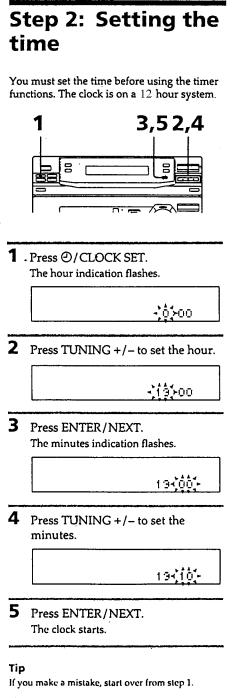
– 6 –
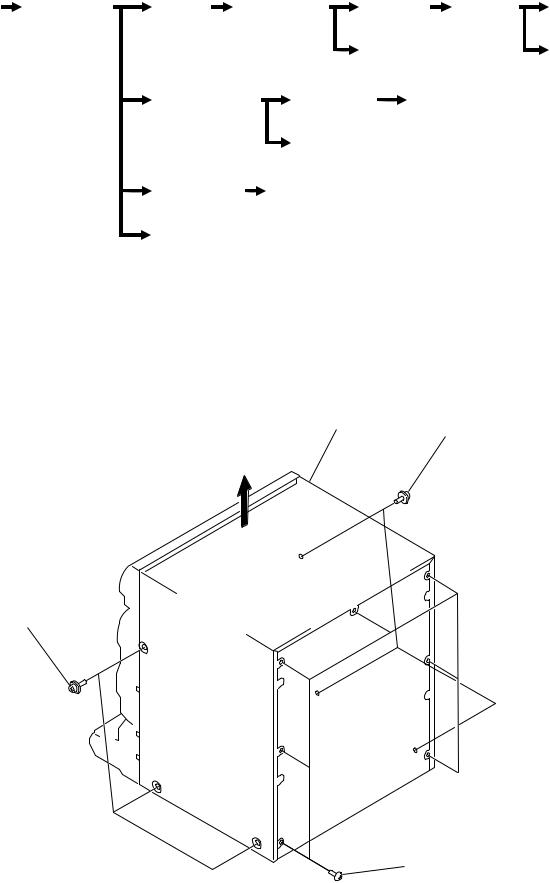
SECTION 3
DISASSEMBLY
• This set can be disassembled in the order shown below.
CASE |
FRONT PANEL |
MAIN |
CD MECHANISM |
BASE UNIT |
BD BOARD |
|||
SECTION |
SECTION |
DECK SECTION |
||||||
(Page 7) |
(Page 12) |
|
(Page 13) |
|||||
(Page 8) |
(Page 9) |
(Page 9) |
|
|||||
|
|
|
|
|||||
|
|
|
|
|
DISC TABLE |
|
||
|
|
|
|
|
(Page 12) |
|
|
|
|
|
TAPE MECHANISM |
AUDIO BOARD |
CAPSTAN MOTOR (M1) |
||||
|
|
DECK SECTION |
|
(Page 14) |
|
(Page 14) |
||
|
|
(Page 10) |
|
|
|
|
|
|
|
|
|
|
CASSETTE |
|
|
|
|
|
|
|
|
LID ASS’Y |
|
|
|
|
|
|
|
|
(Page 10) |
|
|
|
|
|
|
CD LID ASS’Y |
|
PANEL (A)/(B) |
|
|
|
|
|
|
SECTION |
|
SUB ASS’Y |
|
|
|
|
|
|
(Page 11) |
|
(Page 11) |
|
|
|
|
MAIN BOARD (Page 8)
Note: Follow the disassembly procedure in the numerical order given.
CASE
3 case
1 three screws (case 3TP2)
1three screws (case 3 TP2)
2 seven screws (BATT3 × 6)
OPTICAL PICK-UP (Page 13)
SLED MOTOR (Page 13)
– 7 –
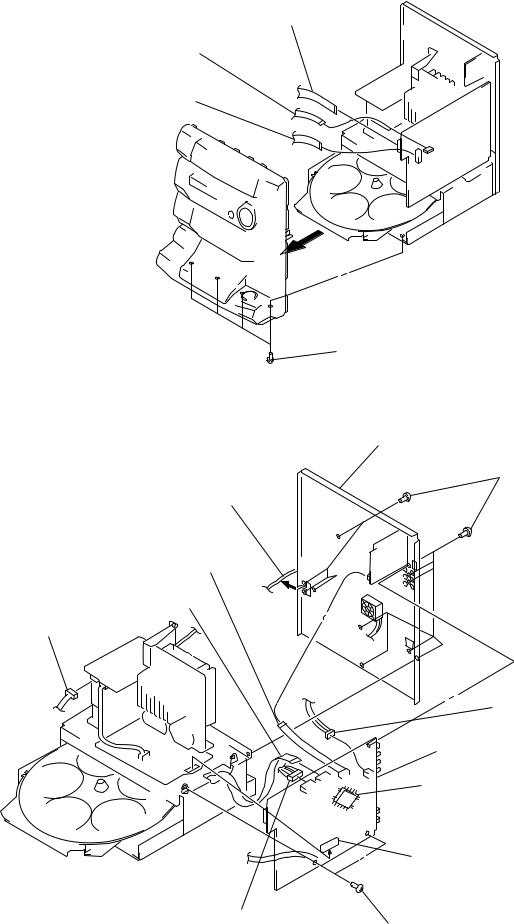
FRONT PANEL SECTION
1 wire (flat type) (21 core) (CN205)
1 wire (flat type) (11 core) (CN206)
1 wire (flat type) (17 core) (CN102)
3 front panel section 
MAIN BOARD
5 power cord
1 wire (flat type)
(13 core) (CN201)
1 wire (flat type)
(19 core) (CN202)
3 connector (CN901)
2 connector (CN203)
2four screws (BVTP3 × 8)
6 back panel
4 eleven screws (BVTP3 × 8)
7 connector (CN105)
0 MAIN board
IC201
9connector (CN101)
8two screws (BVTP3 × 8)
– 8 –
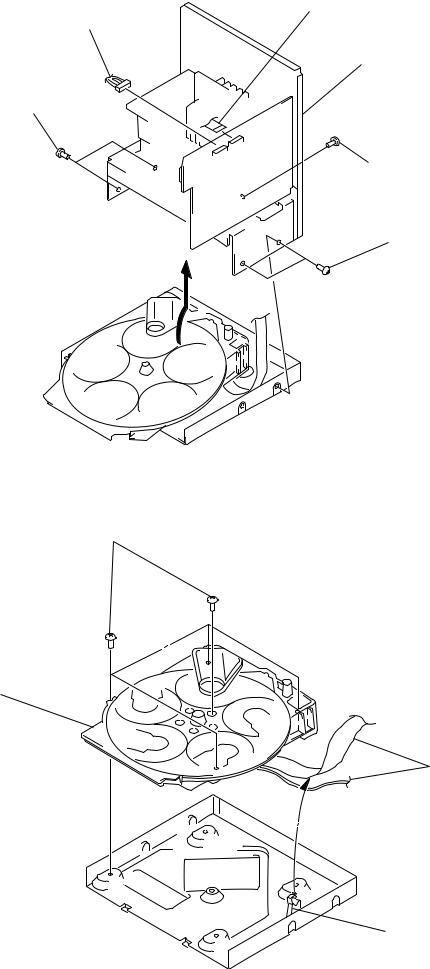
MAIN SECTION |
2 connector |
|
1 flat wire (CN202) |
|
|
|
|
|
(CN203) |
|
|
|
|
|
4 main section |
|
|
|
3two screws (BVTP3 × 8)
3 screw (BVTP3 × 8)
3 two screws (BVTP3 × 8)
CD MECHANISM DECK SECTION (CDM37LH-5BD29AL)
3five screws (BVTP3 × 8)
4 CD mechanism deck section
(CDM37LH-5BD29AL)
2 flat wire
and lead wire
1 Open the clamp.
– 9 –

TAPE MECHANISM DECK SECTION (TCM-220WR2)
4 three screws |
4 three screws |
(BVTP2.6 × 8) |
(BVTP2.6 × 8) |
3 wire (flat type) |
|
(21 core) (CN601) |
5 Remove the tape mechanism deck section |
|
(TCM-220WR2) to direction of the arrow A. |
3 wire (flat type) |
|
(11 core) (CN1001) |
A |
|
2 Open the |
|
cassette lids. |
1 Push the
two buttons.
CASSETTE LID ASS’Y
3 two bracket
2 two screws (BVTP2.6 × 8)
1 two springs
– 10 –
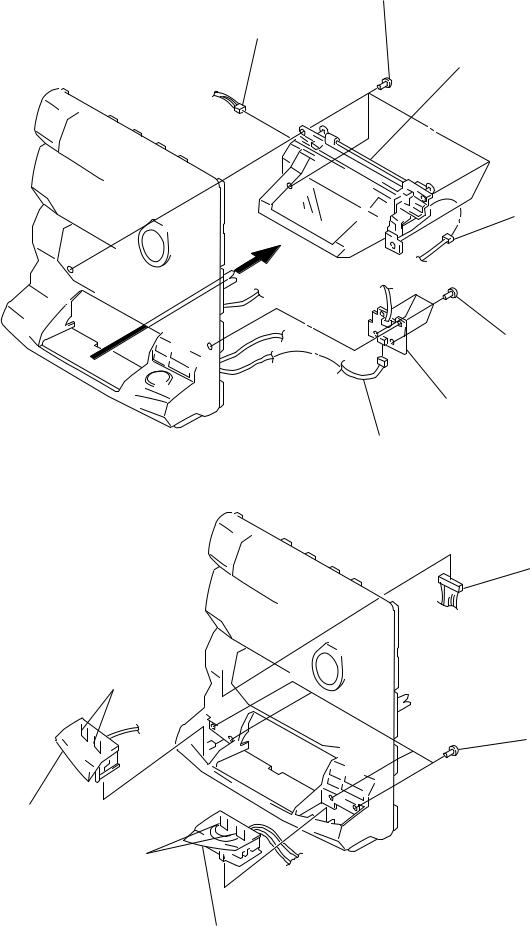
CD LID ASS’Y SECTION |
6 four screws |
|
(BVTP2.6 × 8) |
|
5 connector |
|
(CN671) |
7 CD lid ass’y
4 connector (CN661)
2 four screws (BVTP2.6 × 8)
3 CD-B1 SW board
1 connector (CN642)
PANEL (A) / (B) SUB ASS’Y
1 connector (CN612)
3 two claws
2 four screws (BVTP2.6 × 8)
4 panel (A) sub ass’y
5 two claws
6 panel (B) sub ass’y
– 11 –
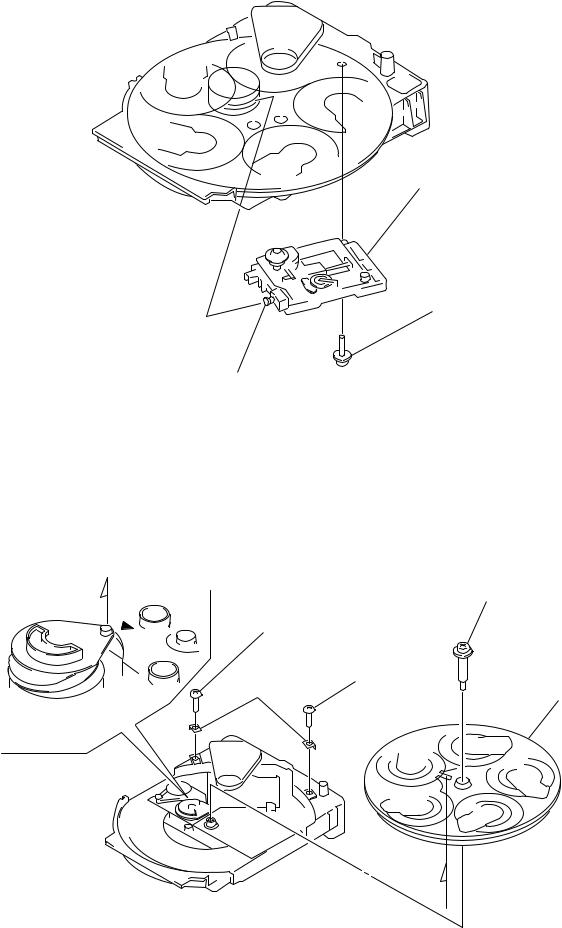
BASE UNIT
3 base unit
1 yoke bracket
2 boss
DISC TABLE
Note:
When the disc table is installed, adjust the positions of roller cam and mark ( as shown in the figure, then set to the groove of disc table.
A
3 step screw
1 screw (BVTP3 × 8)
|
1 screw |
|
2 bracket (BU) |
(BVTP3 × 8) |
4 disc table |
A
– 12 –

BD BOARD
1 two screws |
1 two screws |
× 8) |
|
(PTPWH M2.6 |
|||
(PTPWH M2.6 × 8) |
|||
|
|
2 optical pick-up section
3 two springs
3 two springs
5 screw (BVTP2.6 × 8)
4 wire (flat type)
(16 core) (CN101)
7 BD board
6Removal
the four solders.
limit switch (S101)
OPTICAL PICK-UP (KSS-213D / Q-NP) , SLED MOTOR (M102) , SPINDLE MOTOR (M101)
3 optical pick-up (KSS-213D/Q-NP)
6spindle motor (M101)
4 two screws  (P2 × 3)
(P2 × 3)
2 sled shaft
5 sled motor
(M102)
1 claw
– 13 –
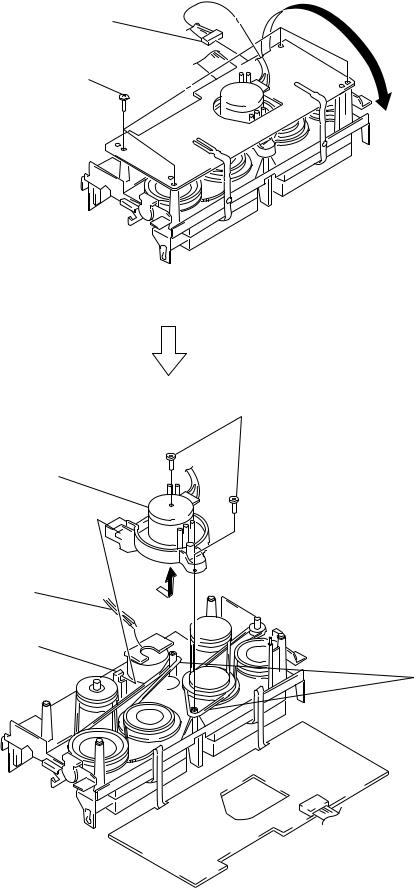
AUDIO BOARD, CAPSTAN MOTOR (M1)
1connector (CN651)
2 four screws |
A |
|
(BTP2.6 × 4) |
||
|
3 Removal the AUDIO board to direction of the arrow A. 
5 two screws (BTP2.6 × 8)
7 Removal the capstan motor (M1) to direction of the arrow B.
4 Break the soldering |
B |
of motor lead. |
|
6 claw |
|
8 Hang two belts.
– 14 –

SECTION 4 TEST MODE
[MC Cold Reset]
• The cold reset clears all data including preset data stored in the RAM to initial conditions. Execute this mode when returning the set to the customer.
Procedure:
1.Press three buttons [SPECTRUM ANALYZER], [ENTER], and
[DISC 1] simultaneously.
2.The fluorescent indicator tube becomes blank instantaneously, and the set is reset.
[CD Delivery Mode]
• This mode moves the pickup to the position durable to vibration. Use this mode when returning the set to the customer after repair.
Procedure:
1.Press I /u button to turn the set ON.
2.Press [PLAY MODE] button and I /u button simultaneously.
3.A message “LOCK” is displayed on the fluorescent indicator tube, and the CD delivery mode is set.
[MC Hot Reset]
• This mode resets the set with the preset data kept stored in the memory. The hot reset mode functions same as if the power cord is plugged in and out.
Procedure:
1.Press three buttons [SPECTRUM ANALYZER], [ENTER], and
[DISC 2] simultaneously.
2.The fluorescent indicator tube becomes blank instantaneously, and the set is reset.
[Sled Servo Mode]
• This mode can run the CD sled motor freely. Use this mode, for instance, when cleaning the pickup.
Procedure:
1.Select the function “CD”.
2.Press three buttons [SPECTRUM ANALYZER], [ENTER], and
[FUNCTION] simultaneously.
3.The Sled Servo mode is selected, if “CD” is blanking on the fluorescent indicator tube.
4.With the CD in stop status, press ) button in CD section to move the pickup to outside track, or 0 button to inside track.
5.To exit from this mode, perform as follows:
1)Move the pickup to the most inside track.
2)Press three buttons in the same manner as step 2.
Note:
•Always move the pickup to most inside track when exiting from this mode. Otherwise, a disc will not be unloaded.
•Do not run the sled motor excessively, otherwise the gear can be chipped.
[Change-over of AM Tuner Step between 9kHz and 10kHz]
• A step of AM channels can be changed over between 9kHz and 10kHz.
Procedure:
1.Press I /u button to turn the set ON.
2.Select the function “TUNER”, and press [TUNER/BAND] button to select the BAND “AM”.
3.Press I /u button to turn the set OFF.
4. Press [ENTER] and I /u buttons simultaneously, and the display of fluorescent indicator tube changes to “AM 9k STEP” or “AM 10k STEP”, and thus the channel step is changed over.
[LED and Fluorescent Indicator Tube All Lit, Key Check
Mode]
Procedure:
1.Press three buttons [SPECTRUM ANALYZER], [ENTER] , and
[DISC 3] simultaneously.
2.LEDs and fluorescent indicator tube are all turned on.
Press [DISC 2] button, and the key check mode is activated.
3.In the key check mode, the fluorescent indicator tube displays “K 1 J0 V0”. Each time a button is pressed, “K”value increases. However, once a button is pressed, it is no longer taken into account.
“J” Value increases like 1, 2, 3 ... if rotating [JOG] knob in “+” direction, or it decreases like 0, 9, 8 ... if rotating in “–”
direction.
“V” Value increases like 1, 2, 3 ... if rotating [VOLUME] knob in “+” direction, or it decreases like 0, 9, 8 ... if rotating in “–” direction.
4.To exit from this mode, press three buttons in the same manner as step 1, or disconnect the power cord.
– 15 –
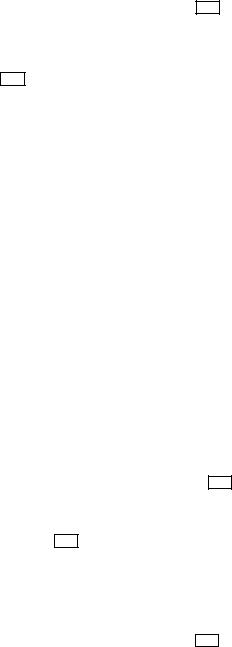
[Aging Mode]
This mode can be used for operation check of CD section and tape deck section.
• If an error occurred:
The aging operation stops.
• If no error occurs:
The aging operation continues repeatedly.
1. Aging Mode in CD Section
1-1. Operating Method of Aging Mode
1.Set discs in DISC 1 and DISC 3 trays.
2.Select the function “CD”.
3.Press three buttons [SPECTRUM ANALYZER] , [ENTER], and [KARAOKE PON/MPX] simultaneously.
4.The aging mode is activated, if a roulette mark on the fluorescent indicator tube is blinking.
5.In the aging mode, the aging is executed in a sequence given in “1-2. Operation during Aging Mode”.
The aging continues unless an alarm occurred.
6.To exit from the aging mode, press I /u button to turn the set OFF.
•If a button other than buttons In CD section is pressed during aging, the aging in the CD section is finished.
•To execute aging to the tape deck section successively, press · button in the deck A.
“AGING” is displayed on the fluorescent indicator tube. (For the aging in tape deck, see “2. Aging Mode in Tape Deck Section”.
1-2. Operation during aging Mode
In the aging mode, the program is executed in the following sequence.
1.The disc tray turns to select a disc. (For a disc selection sequence, see Section 1-3.)
2.TOC of disc is read.
3.The pickup accesses to the last track.
4.Steps 1 through 3 are repeated.
1-3. Disc Selection Sequence
• During the aging mode, discs are selected in the following sequence:
Disc 1 → Disc 3 − ↓
Disc 3 ← Disc 1
2. Aging Mode in Tape Deck Section
2-1. Operating Method of Aging Mode
1.Load a commercially available 10-minute tape into the decks A and B respectively.
(If a 10-minute tape is not available, another tape may be used but a cycle time will be longer.)
2.Select the function “TAPE”.
3.Rewind tapes in advance by pressing 0 button respectively on decks A and B.
4.Press three buttons [SPECTRUM ANALYZER] , [ENTER], and [KARAOKE PON/MPX] simultaneously.
5.Press · button on deck A. (This button triggers the aging mode.)
6.The aging mode is activated if “AGING A” is displayed on the fluorescent indicator tube.
7.In the aging mode, the aging is executed in a sequence given in “2-2. Operation during Aging Mode”.
The aging continues unless an alarm occurred.
8.To exit from the aging mode, press I /u button to turn the set OFF.
2-2. Operation during Aging Mode
In the aging mode, the program is executed in the following sequence.
1.A tape on FWD side is played for one minute.
2.PAUSE STOP is made.
3.Recording is made for 3 minutes. (For the deck not having the record function, the play is executed.)
4.FF is executed up to the end of tape.
5.A tape is reversed, and the tape on REV side is played for one minute.
6.PAUSE STOP is made.
7.Recording is made for 3 minutes. (For the deck not having the record function, the play is executed.)
8.FF is executed up to the end of tape.
9.Steps 1 through 8 are executed for the other deck.
10.Steps 1 through 9 are repeated unless an alarm occurred.
2-3. Deck Selection Sequence
• During the aging mode, decks are selected in the following sequence:
Deck A (FWD) → Deck A (REV) − ↓
Deck B (REV) ← Deck B (FWD)
– 16 –
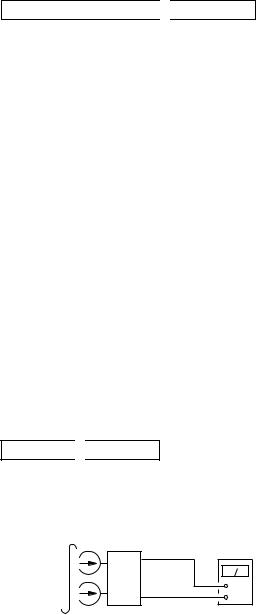
SECTION 5
MECHANICAL ADJUSTMENTS
PRECAUTION
1.Clean the following parts with a denatured-alcohol-moistened swab:
record/playback heads |
pinch rollers |
erase head |
rubber belts |
capstan |
idlers |
2.Demagnetize the record/playback head with a head demagnetizer.
3.Do not use a magnetized screwdriver for the adjustments.
4.After the adjustments, apply suitable locking compound to the parts adjusted.
5.The adjustments should be performed with the rated power supply voltage unless otherwise noted.
•Torque Measurement
•Tape Tension Measurement
•Torque Measurement
Mode |
Torque Meter |
Meter Reading |
||
|
|
|
||
Forward |
CQ-102C |
36 to 61g•cm |
||
(0.50 |
– 0.84 oz•inch) |
|||
|
|
|||
|
|
|
||
Forward |
CQ-102C |
2 to 6g•cm |
||
Back Tension |
(0.026 |
– 0.082 oz•inch) |
||
|
||||
|
|
|
||
Reverse |
CQ-102RC |
36 to 61g•cm |
||
(0.50 |
– 0.84 oz•inch) |
|||
|
|
|||
Reverse |
CQ-102RC |
2 to 6g•cm |
||
Back Tension |
(0.026 |
– 0.082 oz•inch) |
||
|
||||
FF, REW |
CQ-201B |
61 to 143g•cm |
||
(0.85 |
– 1.98 oz•inch) |
|||
|
|
|||
|
|
|
|
|
• Tape Tension Measurement
Mode |
Tension Meter |
Meter Reading |
Forward |
CQ-403A |
more than 100 g (3.52 oz) |
|
|
|
Reverse |
CQ-403R |
more than 100 g (3.52 oz) |
|
|
|
SECTION 6
ELECTRICAL ADJUSTMENTS
TAPE DECK SECTION 
 0 dB=0.775 V
0 dB=0.775 V
1.Demagnetize the record/playback head with a head demagnetizer. (Do not bring the head demagnetizer close to the erase head.)
2.Do not use a magnetized screwdriver for the adjustments.
3.After the adjustments, apply suitable locking compound to the parts adjust.
4.The adjustments should be performed with the rated power supply voltage unless otherwise noted.
5.The adjustments should be performed in the order given in this service manual. (As a general rule, playback circuit adjustment should be completed before performing recording circuit adjustment.)
6.The adjustments should be performed for both L-CH and R- ch.
7.Switches and controls should be set as follows unless otherwise specified.
8.Set to test mode. (Press key switch same time
[SPECTRUM ANALYZER] [ENTER] and [EFFECT] button.)
• Test Tape
Tape |
Signal |
Used for |
|
|
|
P-4-A100 |
10 kHz, –10 dB |
Azimuth Adjustment |
WS-48B |
3 kHz, 0 dB |
Tape Speed Adjustment |
P-4-L300 |
315 Hz, 0 dB |
Level Adjustment |
|
|
|
Record/ Playback Head Azimuth Adjustment
DECK A 
 DECK B
DECK B
Note: Perform this adjustments for both decks
Procedure:
test tape P-4-A100
(10 kHz, –10 dB)
main board CN207
Pin 3 (L-CH)
Pin 1 (R-CH) level meter
set
+
–
main board CN207 Pin 2
– 17 –
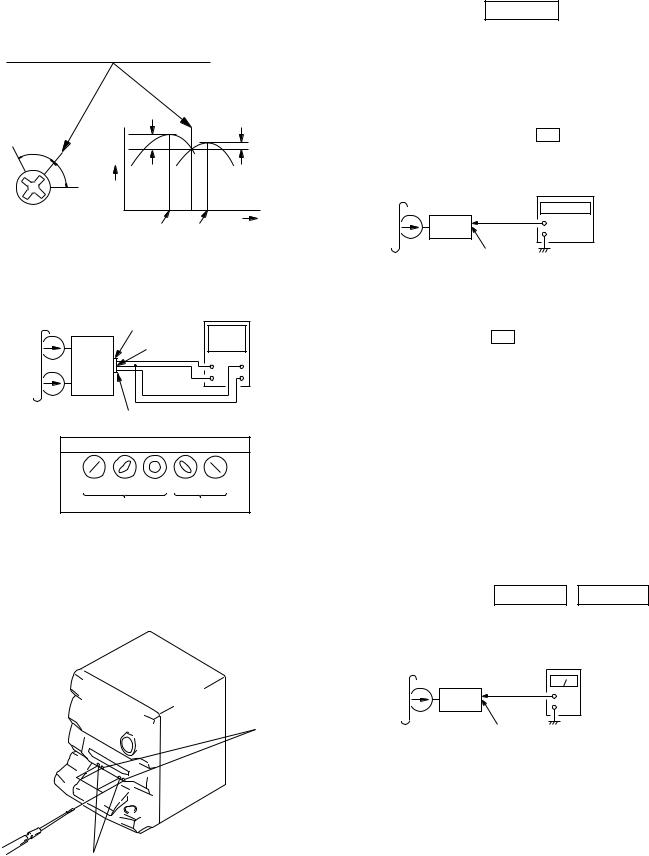
1.Mode: Playback (FWD)
2.Turn the adjustment screw and check output peaks. If the peaks do not match for L-CH and R-CH, turn the adjustment screw so that outputs match within 1dB of peak.
|
within |
|
|
L-CH |
1dB |
|
|
|
|
within |
|
peak |
output |
|
|
|
|
1dB |
|
|
level |
|
|
|
R-CH |
|
|
Screw |
peak |
|
Screw |
|
|
||
position |
L-CH |
R-CH |
position |
|
peak |
peak |
|
3. Mode: Playback (FWD)
test tape |
|
|
|
|
P-4-A100 |
|
oscilloscope |
||
(10 kHz, –10 dB) |
pin 3 |
|||
L-CH |
|
|
||
|
|
|
||
main |
pin 2 |
|
|
|
L |
V |
H |
||
board |
||||
|
||||
CN207 |
R |
|
|
|
set |
|
|
||
|
|
|
||
R-CH
pin 1
waveform of oscilloscope
in phase 45 ° 90 ° 135 ° 180 °
good wrong
4.Repeat steps 1 to 3 in playback (REV) mode.
5.After the adjustments, apply suitable locking compound to the pats adjusted.
Adjustment Location: Record/Playback Head (Deck A and B) and MAIN board.
reverse
forward
Tape Speed Adjustment DECK A
Note: Start the Tape Speed adjustment as below after setting to the test mode.
In the test mode, the tape speed is high during pressing the
[H. SPEED DUBB] button.
Procedure:
1.Turn the power switch on.
2.Press the [SPECTRUM ANALYZER] button, [ENTER] but-
ton and [EFFECT] button simultaneously.
To exit from the test mode, press the I /u button. Mode: Playback (FWD)
test tape
WS-48B frequency counter (3 kHz, 0 dB)
set |
+ |
|
– |
||
|
MAIN board
CN207 (Pin 3 : L-CH) (Pin 1 :R-CH)
1.Insert the WS-48B into the deck A and the blank tape into the deck B.
2.Press the [REC] button and · button on the deck B. Then the deck B is at recording mode.
3.Set the deck A to playback mode.
4.Keep pressing the [H. SPEED DUBB] button in playback mode. Then at HIGH speed mode.
5.Adjust RV652 on the AUDIO board do that frequency counter reads 6,000 ± 60 Hz.
6.Take off the [H. SPEED DUBB] button. Then at NORMAL speed mode.
7.Adjust RV651 on the AUDIO board so that frequency counter reads 3,000 ± 20 Hz.
8.Frequency difference between deck A and deck B the begin-
ning of the tape should be within ± 1.5%.
Adjustment Location: AUDIO and MAIN boards
Sample Value of Wow and flutter: 0.29% or less W. RMS (WS-48B)
Playback level Adjustment |
DECK A |
DECK B |
|
Procedure: |
|
|
|
Mode: Playback (FWD) |
|
|
|
test tape |
|
|
|
P-4-L300 |
level meter |
||
(315 Hz, 0 dB) |
|||
|
|
||
set |
|
+ |
|
|
– |
||
|
|
||
main board
CN207 (Pin 3 : L-CH) (Pin 1 : R-CH)
Deck A is RV311 (L-CH) and RV411 (R-CH), Deck B is RV301 (L-CH) and RV401 (R-CH) so that adjustment within adjustment level as follows.
Adjustment Level:
CN207 PB level: 301.5 to 338.3 mV (–8.2 to –7.2 dB) level difference between the channels: within ± 0.5 dB
Adjustment Location: AUDIO and MAIN boards
– 18 –
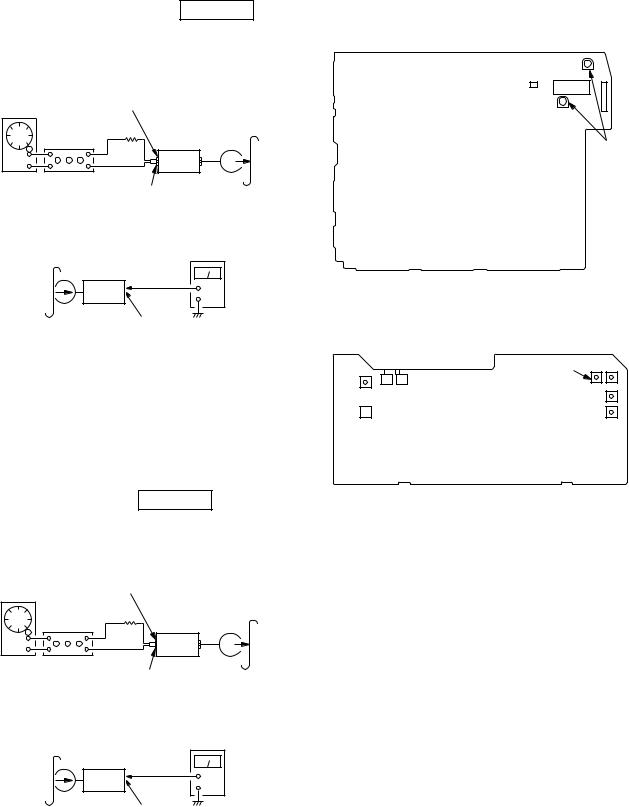
Record bias Current Adjustment DECK B
Procedure:
1. Mode: Record
Pin 6 (L-CH) of IC1501 on the MAIN board. Pin #¶ (R-CH) of IC1501 on the MAIN board.
1)315 Hz ü
2)10 kHz ýþ 50 mV (–23.8 dB)
AF OSC |
blank tape |
|
|
600 Ω |
CN-123 |
attenuator |
|
|
set |
Adjustment Location:
[MAIN BOARD] (Component Side)
|
RV1501 |
|
CN207 |
|
|
1 |
3 |
IC1501 |
CN205
RV1551
RECORD
LEVEL
Pin 2 (GND) of CN207 on the MAIN board.
2. Mode: Playback
recorded portion
|
level meter |
|
set |
+ |
|
– |
||
|
CN207 (Pin 3 : L-CH)
(Pin 1 : R-CH)
Confirm playback the signal recorded in step 1 become adjustable limits as follows.
If these levels do not adjustable limits, adjustment the RV341 (L- CH) and RV441 (R-CH) on the AUDIO board to repeat steps 1 and 2.
Adjustable limits: Playback output of 315 Hz to playback output of 10 kHz: 0 ± 0.5 dB
Adjustment Location: AUDIO and MAIN boards
Record Level Adjustment DECK B
Procedure:
1. Mode: Record
Pin 6 (L-CH) of IC1501 on the MAIN board.
Pin #¶ (R-CH) of IC1501 on the MAIN board.
315 Hz, 50 mV (–23.8 dB) |
|
AF OSC |
blank tape |
|
|
600 Ω |
CS-123 |
attenuator |
|
set |
|
Pin 2 (GND) of CN207 on the MAIN board.
2. Mode: Playback
recorded portion
|
level meter |
|
set |
+ |
|
– |
||
|
CN207 (Pin 3 : L-CH)
(Pin 1 : R-CH)
Confirm playback the signal recorded in step 1 become adjustable limits as follows.
If these levels do not adjustable limits, adjustment the RV1501 (L-CH) and RV1551 (R-CH) on the MAIN board to repeat steps 1 and 2.
Adjustable limits:
CN207 PB level: 36.7 to 41.1 mV (–26.5 to –25.5 dB)
Adjustment Location: MAIN board
[AUDIO BOARD] (Conductor Side)
RECORD
BIAS CURRENT üýþ
R L
RV301 ü 


 RV341 L
RV341 L
ï RV441
ï
R  ý PB LEVEL RV401 þ
ý PB LEVEL RV401 þ
– DECK B –
|
TAPE SPEED |
|||
ü ï ï ï ý ï ï ï þ |
||||
(NORMAL) |
(HIGH) |
|||
|
RV651 |
RV652 |
||
PB |
ü |
RV311 L |
||
ý |
||||
|
|
|||
LEVELþRV411 R |
||||
|
– DECK A – |
|||
*As the adjustment parts is mounted on the component side, adjust it through a hole in the AUDIO board form conductor side. (Except RV431, 441)
– 19 –
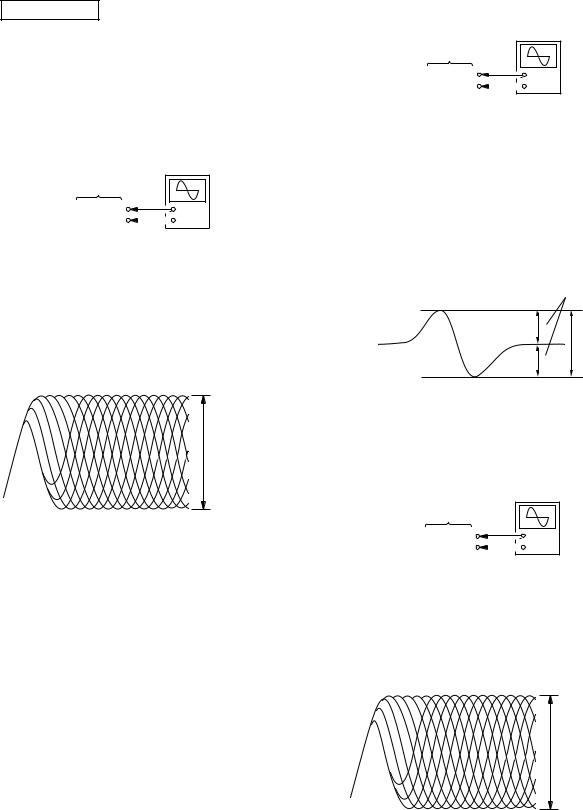
CD SECTION
Note:
1.CD Block is basically designed to operate without adjustment. Therefore, check each item in order given.
2.Use YEDS-18 disc (3-702-101-01) unless otherwise indicated.
3.Use an oscilloscope with more than 10M impedance.
4.Clean the object lens by an applicator with neutral detergent when the signal level is low than specified value with the following checks.
Focus Bias check
|
oscilloscope |
BD board |
|
TP (FEO) |
+ |
TP (VC) |
– |
Procedure:
1.Connect oscilloscope to test point TP (RF). (GND terminal: VC)
2.Turned Power switch on.
3.Put disc (YEDS-18) in and playback.
4.Confirm that the shape “ ” can be clearly distinguished at the center of the waveform and check the RF signal level.
• RF signal
VOLT/DIV: 200 mV
TIME/DIV: 500 ns
level:
1.3 ± 0.3 Vp-p
S Curve Check
|
oscilloscope |
BD board |
|
TP (FEO) |
+ |
TP (VC) |
– |
Procedure:
1.Connect oscilloscope to test point TP (FEO).
2.Connect between test point TP (FOK) and GND by lead wire.
3.Turn Power switch on.
4.Put disc (YEDS-18) in and turned Power switch on again and actuate the focus search. (actuate the focus search when disc table is moving in and out.)
5.Check the oscilloscope waveform (S-curve) is symmetrical between A and B. And confirm peak to peak level within 3 ± 1 Vp-p.
S-curve waveform
symmetry
A
within 3 ± 1 Vp-p
B
6. After check, remove the lead wire connected in step 2.
Note: • Try to measure several times to make sure than the ratio of A : B or B : A is more than 10 : 7.
• Take sweep time as long as possible and light up the brightness to obtain best waveform.
RF Level Check
|
oscilloscope |
BD board |
|
TP (RF) |
+ |
TP (VC) |
– |
Procedure:
1.Connect oscilloscope to test point TP (TEO) on BD board.
2.Turned Power switch on.
3.Put disc (YEDS-18) in to play the number five track.
4.Confirm that oscilloscope waveform is clear and check RF signal level is correct or not.
• SF signal
VOLT/DIV: 200 mV
TIME/DIV: 500 ns
level:
1.3 ± 0.3 Vp-p
Note: Clear RF signal waveform means that the shape “ ” can be clearly distinguished at the center of the waveform.
– 20 –
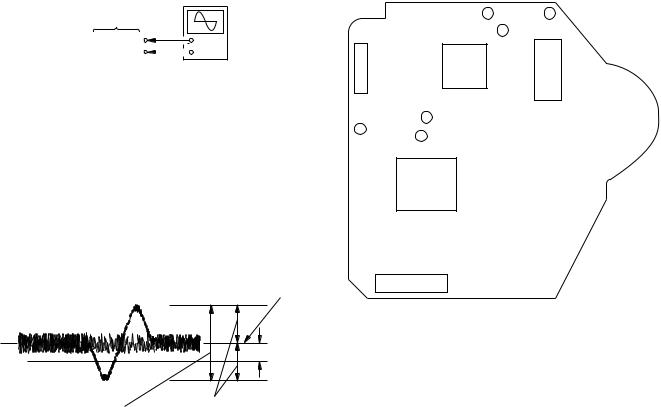
E-F Balance (1 Track Jump) check (Without remote commander)
|
oscilloscope |
BD board |
|
TP (TEO) |
+ |
TP (VC) |
– |
Procedure:
1.Connect oscilloscope to test point TP (TEO) on BD board.
2.Turned Power switch on.
3.Put disc (YEDS-18) in to play the number five track.
4.Press the “ P (Pause)” button. (Becomes the 1 track jump mode)
5.Check the level B of the oscilloscope’s waveform and the A (DC voltage) of the center of the Traverse waveform. Confirm the following:
A – B |
× 100 = ±7 (%) |
|
2 (A + B) |
||
|
1 track jump waveform
Center of the waveform
B
A (DC voltage)
0V
symmetry level : 500 mV ± 100 mVp-p
Adjustment Location:
[BD BOARD] (Conductor Side) |
|
|
|
RF |
VC |
|
|
|
CNU101 |
FOK |
|
IC101 |
IC |
|
|
I02 |
|
|
|
|
|
TEO |
|
GND |
FEO |
|
|
|
|
|
IC103 |
|
CNU102
– 21 –
SECTION 7
DIAGRAMS
7-1. IC PIN FUNCTION DESCRIPTION
• MAIN BOARD IC301 PD780018YGF-028-3BA (SYSTEM CONTROLLER)
Pin No. |
Pin Name |
I/O |
|
|
|
Function |
|
|
||
|
|
|
|
|
|
|||||
1 |
TA-MUTE |
O |
Line muting on/off control signal output terminal |
“L”: muting on |
|
|||||
|
|
|
|
|||||||
2 |
DBFB-H/L |
O |
DBFB normal/high selection signal output to the M62427FP (IC201) |
|||||||
“L”: DBFB high, “H”: DBFB low |
|
|
|
|
|
|
||||
|
|
|
|
|
|
|
|
|
||
|
|
|
|
|
|
|||||
3 |
427-LAT |
O |
Serial data latch pulse output to the M62427FP (IC201) |
|
|
|||||
|
|
|
|
|
|
|
||||
4 |
K-CON-LAT |
O |
Serial data latch pulse output terminal |
Not used (open) |
|
|
||||
|
|
|
|
|
||||||
5 |
K-CON-ON |
O |
On/off selection signal output of the key control circuit “L”: on |
Not used (open) |
||||||
|
|
|
|
|
|
|
||||
6 |
F-RELAY |
O |
Relay drive signal output for the speaker protect |
“H”: on |
|
|
||||
|
|
|
|
|
|
|||||
7 |
R-RELAY |
O |
Relay drive signal output for the speaker protect |
“H”: on |
Not used (open) |
|||||
|
|
|
|
|
|
|||||
8 |
PL-RELAY |
O |
Relay drive signal output for the speaker protect |
“H”: on |
Not used (open) |
|||||
|
|
|
|
|
|
|
|
|
||
9 |
TEST |
I |
Test terminal Connected to ground |
|
|
|
|
|
||
|
|
|
|
|
|
|
|
|||
10 |
X2 |
O |
Main system clock output terminal (5 MHz) |
|
|
|
|
|||
|
|
|
|
|
|
|
|
|||
11 |
X1 |
I |
Main system clock input terminal (5 MHz) |
|
|
|
|
|||
|
|
|
|
|
|
|
|
|
|
|
12 |
VDD |
— |
Power supply terminal (+5V) |
|
|
|
|
|
|
|
|
|
|
|
|
|
|
||||
13 |
XT2 |
O |
Sub system clock output terminal (32.768 kHz) |
|
|
|
||||
|
|
|
|
|
|
|
||||
14 |
XT1 |
I |
Sub system clock input terminal (32.768 kHz) |
|
|
|
||||
|
|
|
|
|
||||||
15 |
RESET |
I |
System reset signal input from the reset signal generator (IC302) |
“L”: reset |
||||||
For several hundreds msec. after the power supply rises, “L” is input, then it changes to “H” |
||||||||||
|
|
|
||||||||
|
|
|
|
|
|
|
|
|
|
|
16 |
(INT/IN) |
I |
Connected to ground |
|
|
|
|
|
|
|
|
|
|
|
|
|
|
|
|
|
|
17 |
(INT/IN/OUT) |
I |
Connected to ground |
|
|
|
|
|
|
|
|
|
|
|
|||||||
18 |
SCOR |
I |
Subcode sync (S0+S1) detection signal input from the CXD2519Q (IC103) |
|||||||
|
|
|
|
|
|
|
|
|||
19 |
SOFT-TEST |
O |
Output terminal for the software test (open) |
|
|
|
|
|||
|
|
|
|
|||||||
20 |
AC-CUT |
I |
AC off detection signal input from the reset signal generator (IC302) |
|||||||
|
|
|
|
|||||||
21 |
RDS-INT |
I |
Serial data reading clock signal input for the radio data system Not used (fixed at “L”) |
|||||||
|
|
|
|
|
|
|
||||
22 |
RDS-DATA |
I |
Serial data input for the radio data system |
Not used (open) |
|
|
||||
|
|
|
|
|
|
|
|
|
|
|
23 |
VDD |
— |
Power supply terminal (+5V) |
|
|
|
|
|
|
|
|
|
|
|
|
|
|||||
24 |
AVDD |
— |
Power supply terminal (+5V) (for A/D conversion) |
|
|
|||||
|
|
|
|
|
|
|||||
25 |
ADJ |
I |
Setting terminal for the CD test mode |
Normally: fixed at “H” |
|
|||||
|
|
|
|
|||||||
26 |
A-SHUT |
I |
Shut off detection signal input from the deck-A side reel pulse detector (Q1001) |
|||||||
|
|
|
|
|||||||
27 |
B-SHUT |
I |
Shut off detection signal input from the deck-B side reel pulse detector (Q1002) |
|||||||
|
|
|
|
|
|
|||||
28 |
B-HALF |
I |
Detection input from the deck-B half detect switch (S1006) |
|
|
|||||
|
|
|
|
|
|
|
|
|
|
|
29 |
CLK-CHECK |
I |
Not used (fixed at “L”) |
|
|
|
|
|
|
|
|
|
|
|
|
|
|
|
|
|
|
30 |
SPEC-IN |
I |
Setting terminal for the version |
|
|
|
|
|
|
|
|
|
|
|
|
|
|
||||
31 |
ADJ2 |
I |
Setting terminal for the CD test mode |
Normally: “L” |
|
|
||||
|
|
|
|
|
|
|
||||
32 |
DEMO-MODE |
I |
Setting terminal for the demonstration H/L |
Fixed at “L” |
|
|
||||
|
|
|
|
|
|
|
|
|
||
33 |
AVSS |
— |
Ground terminal (for A/D conversion) |
|
|
|
|
|
||
|
|
|
|
|
|
|||||
34 |
SQ-DATA-IN |
I |
Sub-code Q data input from the CXD2519Q (IC103) |
|
|
|||||
|
|
|
|
|
|
|
|
|
|
|
35 |
NCO |
O |
Not used (open) |
|
|
|
|
|
|
|
|
|
|
|
|||||||
36 |
SQ-CLK |
O |
Sub-code Q data reading clock signal output to the CXD2519Q (IC103) |
|||||||
|
|
|
|
|
||||||
37 |
SW-ON/OFF |
O |
Super woofer speaker on/off control signal output terminal |
Not used (open) |
||||||
|
|
|
|
|
|
|
|
|||
38 |
FUNC1 |
I |
Setting terminal for the function 1 |
Fixed at “L” |
|
|
|
|||
|
|
|
|
|
|
|
|
|||
39 |
FUNC2 |
I |
Setting terminal for the function 2 |
Fixed at “L” |
|
|
|
|||
|
|
|
|
|
|
|
|
|
|
|
40 |
VSS |
— |
Ground terminal |
|
|
|
|
|
|
|
|
|
|
|
|
|
|
||||
41 |
VOL-LAT |
O |
Serial data latch pulse output terminal |
Not used (open) |
|
|
||||
|
|
|
|
|
|
|
||||
42 |
PL-LAT |
O |
Serial data latch pulse output terminal |
Not used (open) |
|
|
||||
|
|
|
|
|
|
|||||
43 |
COM-DIN |
I |
Serial data input terminal Not used (fixed at “L”) |
|
|
|||||
|
|
|
|
|
|
|
|
|
|
|
– 22 –

Pin No. |
Pin Name |
I/O |
|
|
|
Function |
|
|
|
|
|
|
|
|
|
|
|||
44 |
COM-DOUT |
O |
Serial data output to the M62427FP (IC201) |
|
|
|
|||
|
|
|
|
|
|||||
45 |
COM-CLK |
O |
Serial data transfer clock signal output to the M62427FP (IC201) |
|
|||||
|
|
|
|
||||||
46 |
CD-POWER |
O |
Power on/off control signal output for the CD mechanism deck section |
||||||
“H”: power on, “L”: standby |
|
|
|
|
|
|
|||
|
|
|
|
|
|
|
|
|
|
|
|
|
|
|
|
|
|||
47 |
CD-DATA |
O |
Serial data output to the CXD2519Q (IC103) |
|
|
|
|||
|
|
|
|
|
|||||
48 |
CD-CLK |
O |
Serial data transfer clock signal output to the CXD2519Q (IC103) |
|
|||||
|
|
|
|
|
|
|
|||
49 |
MSM-CND |
O |
Command data output terminal Not used (open) |
|
|
|
|||
|
|
|
|
|
|||||
50 |
MSM-BUSY |
I |
Busy signal input terminal |
“L”: busy status Not used (fixed at “L”) |
|||||
|
|
|
|
|
|
|
|
||
51 |
MSM-LAT |
O |
Serial data latch pulse output terminal |
Not used (open) |
|
|
|
||
|
|
|
|
|
|
|
|
||
52 |
MSM-NAR |
O |
NAR signal output terminal |
Not used (open) |
|
|
|
||
|
|
|
|
|
|
|
|
||
53 |
MSM-CH |
O |
Channel select signal output terminal |
Not used (open) |
|
|
|
||
|
|
|
|
|
|||||
54 |
INPUT- |
O |
Attenuate control (–5 dB) signal output for the input gain control |
|
|||||
CHANGE |
“L”: VIDEO, “H”: MD |
|
|
|
|
|
|
||
|
|
|
|
|
|
|
|
||
|
|
|
|
||||||
55 |
IIC-DATA |
I/O |
Communication data bus with the fluorescent indicator tube driver (IC601) |
||||||
|
|
|
|
||||||
56 |
IIC-CLK |
I/O |
Communication data reading clock signal input or transfer clock signal output with the fluo- |
||||||
rescent indicator tube driver (IC601) |
|
|
|
|
|||||
|
|
|
|
|
|
|
|||
|
|
|
|
||||||
57 |
XRST |
O |
Reset signal output to the CXA1992AR (IC101), BA5941FP (IC102) and CXD2519Q (IC103) on |
||||||
the CD mechanism deck section |
“L”: reset |
|
|
|
|||||
|
|
|
|
|
|
||||
|
|
|
|
|
|
|
|||
58 |
XLT |
O |
Serial data latch pulse output to the CXD2519Q (IC103) |
|
|
|
|||
|
|
|
|
|
|
|
|
||
59 |
WDCL |
O |
Word clock signal output terminal |
Not used (open) |
|
|
|
||
|
|
|
|
|
|||||
60 |
TBL-L |
O |
Motor drive signal output to the disc tray turn motor driver (IC201) |
*1 |
|||||
|
|
|
|
|
|||||
61 |
TBL-R |
O |
Motor drive signal output to the disc tray turn motor driver (IC201) |
*1 |
|||||
|
|
|
|
|
|||||
62 |
TRAY-LED |
O |
LED drive signal output for the CD tray LED indicate “H”: LED on |
|
|||||
|
|
|
|
|
|
|
|
||
63 |
LOAD-OUT |
O |
Motor drive signal output terminal |
Not used (open) |
|
|
|
||
|
|
|
|
|
|
|
|
||
64 |
LOAD-IN |
O |
Motor drive signal output terminal |
Not used (open) |
|
|
|
||
|
|
|
|
|
|||||
65 |
ST-CLK |
O |
PLL serial data transfer clock signal output to the FM/AM tuner unit |
|
|||||
|
|
|
|
|
|
|
|||
66 |
ST-DIN |
I |
PLL serial data input from the FM/AM tuner unit |
|
|
|
|||
|
|
|
|
|
|
|
|||
67 |
ST-DOUT |
O |
PLL serial data output to the FM/AM tuner unit |
|
|
|
|||
|
|
|
|
|
|
|
|||
68 |
ST-CE |
O |
PLL chip enable signal output to the FM/AM tuner unit |
|
|
|
|||
|
|
|
|
|
|||||
69 |
TUNED |
I |
Tuning detection signal input from the FM/AM tuner unit |
“L”: tuned |
|||||
70 |
STEREO |
I |
FM stereo detection signal input from the FM/AM tuner unit |
“L”: stereo |
|||||
|
|
|
|
|
|
|
|
|
|
71 |
VSS |
— |
Ground terminal |
|
|
|
|
|
|
|
|
|
|
|
|||||
72 |
ST-MUTE |
O |
Tuner muting control signal output to the FM/AM tuner unit |
“L”: muting on |
|||||
|
|
|
|
|
|||||
73 |
SENS2 |
I |
Internal status (SENSE) signal input from the CXA1992AR (IC101) |
|
|||||
|
|
|
|
|
|||||
74 |
SENS |
I |
Internal status (SENSE) signal input from the CXD2519Q (IC103) |
|
|||||
|
|
|
|
|
|
||||
75 |
DISC-SENS |
I |
Disc status detection signal input terminal Not used (open) |
|
|
||||
|
|
|
|
||||||
76 |
T-SENS |
I |
Disc tray status detection signal input from the disc tray sensor (IC202) |
||||||
|
|
|
|
|
|
|
|||
77 |
UP SW |
I |
Detection input from the UP switch (S201) |
|
|
|
|||
|
|
|
|
|
|
|
|
|
|
78 |
ENC3 |
I |
|
|
|
|
|
|
|
|
|
|
|
|
|||||
79 |
ENC2 |
I |
Rotary encoder pulse input for the disc tray address detect |
Not used (open) |
|||||
|
|
|
|
|
|
|
|
|
|
80 |
ENC1 |
I |
|
|
|
|
|
|
|
|
|
|
|
||||||
81 |
OUT-OPEN |
I |
Disc tray open/close detect switch input terminal “L”: open, “H”: close Not used (open) |
||||||
|
|
|
|
|
|||||
82 |
CAP-H/N |
O |
High/normal speed selection signal output of the capstan motor (M1) |
|
|||||
“L”: high speed, “H”: normal speed |
|
|
|
|
|||||
|
|
|
|
|
|
|
|||
|
|
|
|
|
|
||||
83 |
A-TRG |
O |
Motor drive signal output to the trigger motor driver (IC1502) |
|
|
||||
|
|
|
|
|
|
||||
84 |
B-TRG |
O |
Motor drive signal output to the trigger motor driver (IC1502) |
|
|
||||
|
|
|
|
|
|||||
85 |
TRG-LOW |
O |
Motor control signal output to the trigger motor driver (IC1502) |
|
|||||
|
|
|
|
|
|
|
|
|
|
– 23 –

Pin No. |
Pin Name |
I/O |
|
|
|
|
|
Function |
|
|
|
|
|
|
|
|
|
|
|||||||
86 |
CAP-M-ON/OFF |
O |
|
Capstan motor (M1) on/off control signal output terminal |
“L”: capstan motor on |
|||||||
|
|
|
|
|
||||||||
87 |
PB-A/B |
O |
|
Deck-A/B selection signal output to the HA12203NT (IC1501) “L”: deck-A, “H”: deck-B |
||||||||
|
|
|
|
|
|
|||||||
88 |
EQ-H/N |
O |
|
Normal/high speed selection signal output to the HA12203NT (IC1501) |
||||||||
|
“L”: normal speed, “H”: high speed |
|
|
|
|
|||||||
|
|
|
|
|
|
|
|
|
||||
|
|
|
|
|
|
|||||||
89 |
BIAS |
O |
|
Recording bias on/off selection signal output to the HA12203NT (IC1501) |
||||||||
|
“L”: bias off, “H”: bias on |
|
|
|
|
|||||||
|
|
|
|
|
|
|
|
|
||||
|
|
|
|
|
|
|||||||
90 |
REC-MUTE |
O |
|
Recording muting on/off selection signal output to the HA12203NT (IC1501) |
||||||||
|
“L”: muting on, “H”: muting off |
|
|
|
|
|||||||
|
|
|
|
|
|
|
|
|
||||
|
|
|
|
|
|
|||||||
91 |
NR-ON/OFF |
O |
|
Dolby NR on/off selection signal output to the HA12203NT (IC1501) |
||||||||
|
“L”: dolby off, “H”: dolby on |
|
|
|
|
|||||||
|
|
|
|
|
|
|
|
|
||||
|
|
|
|
|
|
|||||||
92 |
R/P-PASS |
O |
|
Recording/playback/pass selection signal output to the HA12203NT (IC1501) |
||||||||
|
“L”: recording mode |
|
|
|
|
|||||||
|
|
|
|
|
|
|
|
|
||||
|
|
|
|
|
|
|||||||
93 |
TC-MUTE |
O |
|
Line muting on/off selection signal output to the HA12203NT (IC1501) |
||||||||
|
“L”: muting off, “H”: muting on |
|
|
|
|
|||||||
|
|
|
|
|
|
|
|
|
||||
|
|
|
|
|
|
|||||||
94 |
A-PLAY-SW |
I |
|
Detection input from the deck- A play detect switch (S1001) |
“H”: deck-A play |
|||||||
|
|
|
|
|
|
|||||||
95 |
B-PLAY-SW |
I |
|
Detection input from the deck- B play detect switch (S1002) |
“H”: deck-B play |
|||||||
|
|
|
|
|
|
|||||||
96 |
RELAY |
O |
|
Recording/playback select signal output to the REC/PB switch (IC602) |
||||||||
|
“L”: playback, “H”: recording |
|
|
|
|
|||||||
|
|
|
|
|
|
|
|
|
||||
|
|
|
|
|
|
|||||||
97 |
A-HALF |
I |
|
Detection input from the deck-A cassette detect switch (S1003) |
||||||||
|
“L”: cassette in, “H”: no cassette |
|
|
|
|
|||||||
|
|
|
|
|
|
|
|
|
||||
|
|
|
|
|
|
|||||||
98 |
POWER |
O |
|
Power on/off control signal output for the audio system (+5V) and deck, panel, audio system |
||||||||
|
(+7V and –7V) |
“L”: power on, “H”: standby |
|
|
|
|||||||
|
|
|
|
|
|
|
|
|||||
99 |
SW-F-CON |
O |
|
Super woofer mode control signal output to the M62427FP (IC201) “H”: music, “L”: movie |
||||||||
|
|
|
|
|
|
|||||||
100 |
STK-MUTE |
O |
|
Power amplifier on/off selection signal output terminal |
“L”: on, “H”: standby |
|||||||
|
|
|
|
|
|
|
|
|
|
|||
*1 Disc tray turn motor (M201) control |
|
|
|
|
|
|
||||||
|
|
|
|
|
|
|
|
|
|
|
|
|
|
Mode |
|
|
STOP |
|
COUNTER- |
|
CLOCKWISE |
|
BRAKE |
|
|
Terminal |
|
|
|
|
CLOCKWISE |
|
|
|
||||
|
|
|
|
|
|
|
|
|
|
|
||
|
|
|
|
|
|
|
|
|
|
|
|
|
TBL-L (pin ^º) |
|
|
“H” |
|
“L” |
|
“H” |
|
“L” |
|
||
|
|
|
|
|
|
|
|
|
|
|
|
|
TBL-R (pin ^¡) |
|
|
“H” |
|
“H” |
|
“L” |
|
“L” |
|
||
|
|
|
|
|
|
|
|
|
|
|
|
|
– 24 –
